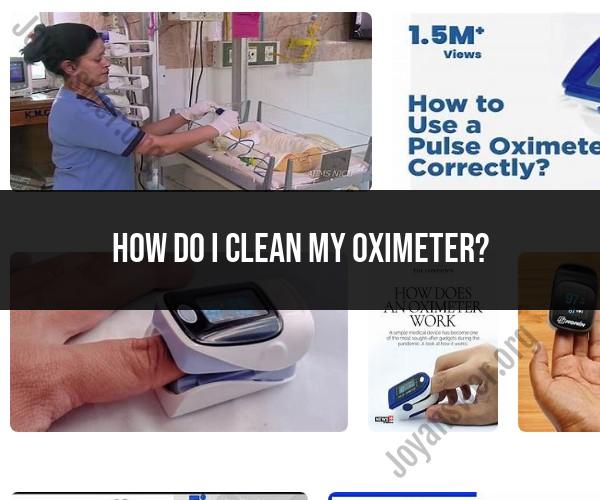How do I Clean my oximeter?
Cleaning your oximeter is essential to ensure accurate and hygienic measurements. Oximeters are often used to measure blood oxygen levels and pulse rate, and cleanliness is critical to prevent cross-contamination. Here are steps on how to clean your oximeter properly:
Materials Needed:
- Isopropyl alcohol wipes (70% or higher concentration)
- Soft, lint-free cloth
- Mild soap and water (for some models)
- Cotton swabs (optional)
Steps to Clean Your Oximeter:
Wash Your Hands: Before handling the oximeter, wash your hands thoroughly with soap and water. This helps prevent transferring any dirt or germs to the device.
Turn Off the Oximeter: If your oximeter has an on/off button, turn it off to avoid unintentional readings during cleaning.
Remove the Batteries: If your oximeter uses disposable batteries, remove them. If the oximeter has a rechargeable battery, make sure it's fully charged before cleaning.
Use Isopropyl Alcohol Wipes:
- Take an isopropyl alcohol wipe and gently clean the exterior of the oximeter, including the display screen, buttons, and the area where you insert your finger. Do not allow liquid to enter any openings on the device.
- Avoid using abrasive materials or harsh chemicals, as they can damage the device's surface.
Dry Thoroughly: After wiping the device with alcohol, use a soft, lint-free cloth to dry it. Make sure there is no residual moisture left on the oximeter.
Clean the Finger Insert Area: If your oximeter has a removable finger insert or probe, remove it (if possible) and clean it with an alcohol wipe. Some oximeters also have a soft silicone or rubber insert. Be gentle when cleaning it, and ensure it's completely dry before reinserting it into the oximeter.
Inspect for Damage: While cleaning, inspect the device for any signs of damage, such as cracks or loose parts. If you notice any damage, consult the user manual or contact the manufacturer for guidance on repair or replacement.
Batteries and Power: If you removed the batteries, reinsert them, or turn the device on if necessary.
Frequency of Cleaning: The frequency of cleaning your oximeter may depend on the frequency of use. In clinical settings or if the oximeter is used by multiple people, it should be cleaned before and after each use. For personal use, cleaning it weekly or as needed is generally sufficient.
Disinfection: In cases where the oximeter is exposed to potential pathogens (e.g., in a healthcare setting), more rigorous disinfection procedures may be required. Consult your healthcare facility's infection control protocols for guidance.
It's important to follow the manufacturer's instructions and recommendations for cleaning and maintenance, as they may vary from one oximeter model to another. Proper cleaning helps ensure the accuracy of readings and reduces the risk of contamination, particularly in healthcare and clinical settings.
How to Clean Your Oximeter: Tips for Device Maintenance
Regular cleaning and maintenance of your oximeter is essential for ensuring its accuracy, hygiene, and longevity. Here are some tips:
- Clean your oximeter after each use. This will help to remove any dirt, sweat, or other contaminants that may have accumulated on the device.
- Use a mild soap and water solution to clean the oximeter. Avoid using harsh chemicals or abrasive cleaners, as these can damage the device.
- Pay special attention to the sensor area. This is the part of the oximeter that comes into contact with your skin. Be sure to clean it thoroughly to remove any dirt or sweat that may have accumulated.
- Allow the oximeter to dry completely before using it again.
Ensuring Accuracy and Hygiene in Oximeter Care
It is important to follow the manufacturer's instructions carefully when cleaning your oximeter. Failure to do so may void the warranty or damage the device.
It is also important to clean your oximeter regularly to ensure its accuracy. Dirt and sweat on the sensor area can interfere with the device's ability to read your oxygen saturation levels accurately.
Cleaning Steps and Best Practices for Oximeter Users
Here are the steps on how to clean your oximeter:
- Turn off the oximeter and remove the batteries.
- Dampen a soft cloth with a mild soap and water solution.
- Wipe down the entire oximeter, paying special attention to the sensor area.
- Dry the oximeter completely with a clean, soft cloth.
- Replace the batteries and turn on the oximeter.
Preserving Your Oximeter's Longevity and Performance
By following the tips above, you can help to preserve your oximeter's longevity and performance. Here are some additional tips:
- Store your oximeter in a cool, dry place. Avoid storing it in direct sunlight or in humid conditions.
- Handle your oximeter with care. Avoid dropping or bumping it.
- Take your oximeter in for regular servicing. This will help to ensure that it is in good working order and that it is calibrated correctly.
Personal Insights and Advice on Oximeter Cleaning
I personally recommend cleaning your oximeter after each use. This is especially important if you are using it in a medical setting or if you are sharing it with others.
When cleaning your oximeter, be sure to use a mild soap and water solution. Avoid using harsh chemicals or abrasive cleaners, as these can damage the device.
Also, be sure to pay special attention to the sensor area. This is the part of the oximeter that comes into contact with your skin. Be sure to clean it thoroughly to remove any dirt or sweat that may have accumulated.
By following these tips, you can help to ensure that your oximeter is accurate and hygienic, and that it lasts for many years to come.












